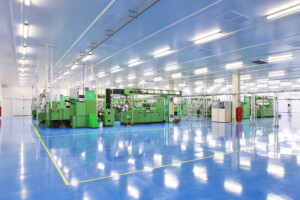 Putting your processes closer together in manufacturing obviously saves space. However, there are many more benefits of putting processes closer together. Let me give you a run down of the benefits:
Putting your processes closer together in manufacturing obviously saves space. However, there are many more benefits of putting processes closer together. Let me give you a run down of the benefits:
Space
 The obvious benefit is to require less space for your machines. Shop floor space does cost money (regardless if rented or owned). Albeit, the actual saving on space may be hard to materialize (it is tough to rent out a corner of your workshop). Yet, it does give you more space to put other stuff for expansion. I have yet to see a factory that thought it had too much space. But freeing up space is only the start of the many benefits of putting machines and processes closer together.
The obvious benefit is to require less space for your machines. Shop floor space does cost money (regardless if rented or owned). Albeit, the actual saving on space may be hard to materialize (it is tough to rent out a corner of your workshop). Yet, it does give you more space to put other stuff for expansion. I have yet to see a factory that thought it had too much space. But freeing up space is only the start of the many benefits of putting machines and processes closer together.
Inventory
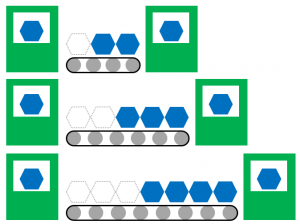 Inventory between processes usually needs to be managed, and there should be a limit on the inventory between two processes. Ideally, you have a FIFO that organizes and limits your inventory, but this inventory management is often neglected, and the work-in-progress inventory (WIP) is whatever it happens to be.
Inventory between processes usually needs to be managed, and there should be a limit on the inventory between two processes. Ideally, you have a FIFO that organizes and limits your inventory, but this inventory management is often neglected, and the work-in-progress inventory (WIP) is whatever it happens to be.
Having your processes closer together automatically gives you less space for your inventory, especially in a flow shop type of manufacturing. Even if the inventory is not explicitly managed, the space constraint simply limits how much there can be.
Material Handling
 Having processes closer together also has the potential to reduce material handling if the material goes directly to the next process. If the material goes from one process to a central warehouse and then to the next process, then there is no benefit, as the material has to be brought to the warehouse regardless of how close together the processes are. Here, the distance to the warehouse is more relevant.
Having processes closer together also has the potential to reduce material handling if the material goes directly to the next process. If the material goes from one process to a central warehouse and then to the next process, then there is no benefit, as the material has to be brought to the warehouse regardless of how close together the processes are. Here, the distance to the warehouse is more relevant.
However, if the material flows along a line of some sort, closeness can have some advantages for material handling. If the processes are farther apart, someone needs to take the material out of the process, someone (else?) needs to move it to the next process, and someone (else) has to put it in the next process again. That makes (usually) three handling steps that have to be done either by people or by logistic processes.
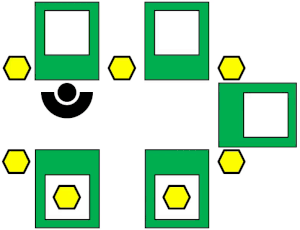
If there is little inventory between processes and the processes are close enough, then it may be possible to eliminate one of these steps. The part is taken out of the first process. The next process is close enough that it can pick up the part directly, without any additional material handling. You saved the extra transport step. This is common in Chaku-Chaku lines, where the preceding process ejects the part automatically, and the worker then puts the part in the next process, a mix of automatic and manual material handling. (Ejecting a part from the machine into a random position is much easier to automate than putting the part into a defined position in the next machine. Hence, ejection is often automatic, and inserting in the next machine is often manual).
If you manage to have no inventory at all between the processes, then the same movement can both remove the part from the previous machine and place it into the next machine. In this case, it may be possible to move the part between processes while touching it once, instead of having it touched twice or three times by different people or logistic processes.
Lead Time
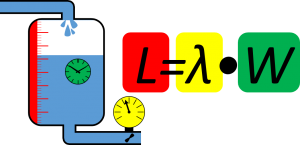
The main factor determining the lead time within the production processes is usually inventory (assuming you are not missing parts that are delayed, or are waiting for product development). Little’s Law determines the lead time through the inventory in the line and the line takt. Hence, less inventory usually means faster lead time, among many other benefits of reduced inventory (see my post on The Hidden and Not-So-Hidden Costs of Inventory).
Information Delay
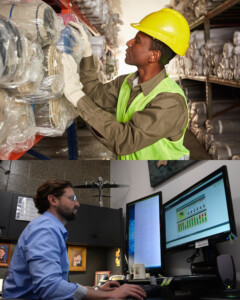
It is not only material that takes more time to cover the distance. Information flow is also affected by distance. Nowadays, a lot of information flows digitally, and it does not matter if the next computer is in the same room or on the other side of the world.
However, what many forget is that a lot of information still flows not digitally but through humans. This may include listening to others as well as looking at things, but also other senses like touch, smell, temperature, or in some cases even taste, vibration, and more. All of these benefit from being close to the source.
For example, there is a lot of “soft” information flowing in a manufacturing line. If the worker at one station is close to another station, he is much more likely to exchange information (e.g., on upcoming changes or problems in the production). He may help by giving advice or getting hands-on to solve a problem for the colleague.
Having people around you also may make the workplace a nicer environment. While in America workers are often seen merely as biological machines, they are indeed humans, and benefit from social interaction, which in turn benefits the workplace.
Many lean processes like Just in Time (JIT) and Just in Sequence (JIS) are much harder to pull off if you have longer distances with a resulting delay in material and information flow.
Visual Management
 Yet another often overlooked benefit is visual management. Sometimes, visual management is seen as putting stickers and labels everywhere and hanging up andon boards. This is often helpful, but I see it merely as an add-on to an easy-to-understand shop floor. The first step in visual management is to create an environment that is easy to observe.
Yet another often overlooked benefit is visual management. Sometimes, visual management is seen as putting stickers and labels everywhere and hanging up andon boards. This is often helpful, but I see it merely as an add-on to an easy-to-understand shop floor. The first step in visual management is to create an environment that is easy to observe.
At a glance, you should see how much material you have where, which machines have problems, and what jobs are being worked on. If you rely only on color and labels for this, then you have already failed. The bigger (and often more difficult) part is to make the shop floor easy to observe. And, in my view, processes being close to each other can contribute to an easier understanding of the situation on hand.
Synchronizing
Also, the closer the processes are together, the easier they are to synchronize and to balance the line. At the very least it is much easier to see if the machines or processes work at different speeds. (Many thanks to Mark Warren for the suggestion to add this)
Also Outside of the Factory
 Being close together helps for processes within a factory. However, it can also help across different factories. Toyota has most of its suppliers within a two-hour drive of its main plant in Toyota City. Car makers often try to get the seat maker to set up a plant just across the street to enable a Just in Sequence production of car seats.
Being close together helps for processes within a factory. However, it can also help across different factories. Toyota has most of its suppliers within a two-hour drive of its main plant in Toyota City. Car makers often try to get the seat maker to set up a plant just across the street to enable a Just in Sequence production of car seats.
Summary
Overall, putting your processes closer together can have quite some benefits. For example, I once worked for a car parts plant. Their problem was that there was a new highway to be constructed, and that highway went right through their property. As a result, they lost HALF of their manufacturing space to public infrastructure, and they were forced to move closer together. VERY much so. The process was not easy, and it involved a lot of complaining about the bloody government and its roads. However, the company managed and re-organized production with half the space (plus some outsourcing). What really surprised them afterward was how much more efficient the plant became. While they didn’t understand how, except for getting everything closer together, lots of costs went down. Quality went up. Speed increased.
Overall, being closer together in manufacturing has many benefits. Now, go out, get cozy with each other(‘s processes), and organize your industry!

a very helpful article as I am planning a new operation for medical devices in Shanghai the next few month. I really agree, that the useage of space is very important and reduces several waste factors (inventory, transport, waiting, movement) and enhances material flow ! Thank´s Christoph